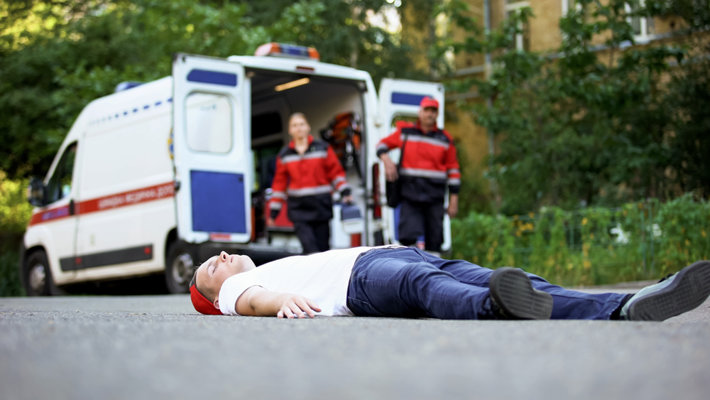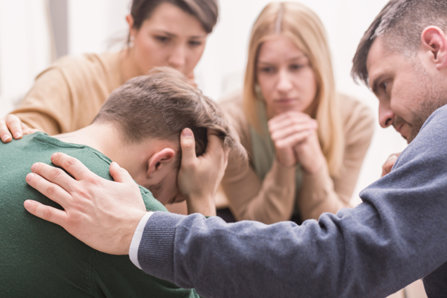What Actually Happens During an Opiate Overdose?

To understand that drug overdoses are a real threat to our family members and loved ones, all one needs to do is take a glance at overdose statistics. Every year since the turn of the century, the numbers of overdoses rise higher and higher as more people lose their lives to such a grievous and yet totally preventable phenomenon.
Of all the drugs that are causing fatal overdoses, opiates are the most lethal of them all. About 702,000 people died from drug overdoses between 1999 and 2017, with opioids involved in almost 68 percent of those deaths.
But what occurs during an overdose? And more importantly, what can be done to prevent them?
An Opiate Overdose—What Happens During Such a Life-Threatening Event
For the last two decades, the U.S. has experienced a shocking surge in opiate deaths. The U.S. went from suffering the loss of 8,048 people to opiates in 1999 to suffering 47,600 such deaths in 2017. Hundreds of thousands of Americans have lost their lives from opiates just since the turn of the century.
What occurs, physiologically, during an overdose? Can this be explained in simple terms? Most people don’t fully understand the phenomenon. Yet many would agree that the key to solving the problem is first understanding it. And yes, opiate overdoses can be explained in simple terms.
First of all, an individual who is on the verge of an overdose rarely realizes that this is the case. Because an overdose occurs during a high, the addict is rarely conscious and aware enough to notice the initial onset symptoms of an overdose. And as the overdose progresses, he becomes less and less likely to realize what is happening to him. That’s part of the reason why the majority of fatal overdoses occur when the addict is on his own.

The first signs of an opiate overdose are extreme drowsiness, cold hands, nausea, vomiting, difficulty thinking, and slowed breathing. These are all effects of opioid molecules spreading through the bloodstream and hitting opioid receptors. Once the opioid molecules get across the blood-brain barrier, the molecules latch onto the reward circuitry of the brain, in an area called the nucleus accumbens.
That’s what leads to the rush of happiness and euphoria that addicts seek. However, almost immediately after that rush, the high evens out, and the user will start to feel extremely tired.
As drowsiness sets in, breathing begins to slow. Not only do opioid molecules influence the reward center of the brain, but they also affect the systems of the brain that control sleep and breathing. Breathing is an automatic, brain-driven activity, but opiates have a powerful impact on that control center. During an opiate overdose, those drug molecules force a severe slowdown in breathing, slowing breathing to the point where it stops completely.
As oxygen levels recede, the user’s heart slows down. Neurological systems are suppressed due to opiate molecules spreading across the brain. That can also lead to irregular heart rhythms, causing some addicts to suffer a sudden cardiac arrest. But if a cardiac arrest does not occur, heart rate will continue to slow dramatically as breathing slows.
The human brain requires a regular dose of oxygen to function correctly. As breathing slows, brain damage can set in. CPR can help the addict avoid permanent brain damage and prevent the heart from stopping completely. And again, that’s why most fatal overdoses occur when the addict is alone. If no one is around to administer naloxone or CPR, the addict will sadly continue to fade away until their heart rate flatlines.
Other phenomena can occur during an overdose, such as foaming at the mouth, aspiration, or cardiac arrest, as mentioned earlier. But the fatal aspect of an opiate overdose is the fact that opiates slow breathing and heart rate to the point where the heart and lungs cease functioning altogether. Death follows shortly after.
What Makes an Overdose More Likely to Occur?
Anyone who uses opiates can experience an overdose. An overdose is a purely physiological phenomenon. It can occur no matter how much an addict thinks they “know how to use drugs.”
However, some circumstances can make an overdose more likely. For example, if someone hasn’t used opiates in a while, and they return to drug use, their bodies won’t be as used to having the drug substance in their system. Their tolerance for the drug will have dropped. The result? The individual takes as much of the drug as they think they are used to, but their body is no longer accustomed to that quantity of opiates. The result is an overdose.
Another factor that can increase the likelihood of an overdose is when an addict mixes opiates with other sedatives like alcohol or benzodiazepines. The combined effect of multiple sedative drugs at once can push an addict’s body into an overdose.
Yet another factor, and this is the most common one, is simply taking too much of an opiate drug. And a lot of times this can happen totally unbeknownst to the individual. He consumes a dose of heroin, thinking it was just heroin, but it could be heroin spliced with fentanyl, a far more potent opiate. The result? An overdose, because the addict is consuming a far more potent dose of opiates than he thought.
Seek Addiction Treatment, Save a Life

Most opiate overdoses are unintentional. That may seem counterintuitive, as most overdoses occur because an addict knowingly took a drug that then caused the overdose. But the nature of drug use is unpredictable and extremely dangerous. Addicts gamble with their lives every time they use drugs.
But the fact remains, the vast majority of addicts are not trying to experience an overdose. They want to go on living, and they even want to get off of drugs at some point. Sadly, many addicts do not feel that they can get clean, as badly as they might want to. That’s why the family members and loved ones of addicts must step in and help their loved ones get better.
While there are methods and emergency medical response techniques for saving someone who is overdosing, merely knowing how to respond to a loved one’s overdose is not a permanent solution. You should know how to respond to an OD because you could wind up saving a life one day. But you cannot monitor your loved one 24/7.
After an overdose, it is crucial that the individual receives treatment to address their addiction and the underlying causes. Residential drug treatment offers a solution to drug addiction.
If you know someone who is struggling with an addiction to opiates, please do everything you can to help them get into treatment as soon as possible. Every time your loved one uses opiates is another roll of the dice with their life.
Narconon can halt the dwindling spiral of addiction. Narconon saves the lives of those who feel as though nothing can help them get better. Even if your loved one isn’t currently open to the idea of addiction treatment, please reach out to Narconon today, so we can start working on getting your loved one help before it is too late.
Sources:
- https://www.cdc.gov/drugoverdose/index.html
- https://www.drugabuse.gov/related-topics/trends-statistics/overdose-death-rates
- https://www.vice.com/en_us/article/a3dzyb/this-is-exactly-what-happens-when-you-overdose
- https://www.cdc.gov/niosh/topics/opioids/response.html
Reviewed by Claire Pinelli, ICAADC, CCS, LADC, RAS, MCAP
